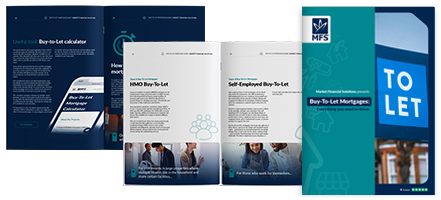Disclaimer
Market Financial Solutions are a bridging loan and buy-to-let mortgage provider and are not legal, financial, investment or tax advisers. This document is for informational purposes only and does not, and should not be considered, to constitute legal, financial, investment or tax advice or be relied upon by any person to make a legal, financial, investment or tax decision. Therefore, Investors are encouraged to seek appropriate professional advice. The information in this content is correct at time of writing.

In an ever-changing mortgage market, brokers play a pivotal role in helping their clients secure the finance they need for their property investments. Due to the economic turbulence we’ve witnessed in the last two years, this has become increasingly important.
Indeed, with high street lenders tightening their lending criteria in response to the new high interest rate environment, many borrowers have been finding it more difficult to access the products, flexibility, and assurances they need to progress.
In the face of such challenges, investors and landlords will be considering ways in which they can maximise the potential of their property investments. In a market where opportunities continue to emerge, but financial options are somewhat limited, brokers are likely to be receiving enquiries from borrowers about how to increase the amount of their mortgage loan to capitalise on such opportunities.
Whether it is to take on a property with greater growth potential, or one in a prime location that is known for its resilience, this blog will outline some of the ways in which brokers can help their client increase the amount of mortgage loan they could acquire.
How to increase amount of mortgage loan
So, what are some of the ways in which brokers can increase the amount that their clients can secure for a mortgage from a lender?
1. Increase the deposit
One option is to increase the amount that a borrower pays for the deposit on a property. Typically, the more money a borrower puts into a mortgage, the more a lender will be willing to lend.
This is because a larger down payment demonstrates that the borrower is financially responsible and contributes to reducing the loan-to-value ratio. This cuts the risk for a lender.
As a result, a lender will likely be more willing to supply a larger loan. To calculate how a larger deposit could impact a mortgage application, try out our buy-to-let mortgage calculator.
2. Look at longer-term mortgages
Another option when considering how to increase the amount of a mortgage loan is to look to longer-term mortgages.
By spreading out the cost of a mortgage across a protracted period of time, borrowers will likely have more manageable monthly payments, and a smaller debt burden to pay each month.
As a result, they may be seen as less of a risk by lenders, who may then be willing to deliver a larger loan.
3. Reduce a borrower’s debt
Lenders often evaluate a borrower’s debt-to-income ratio as a key factor in determining loan eligibility. It reflects the proportion of a borrower’s income that goes towards managing their debts. A lower ratio is generally seen as more favourable by lenders.
Therefore, encouraging borrowers to pay off outstanding personal debts or credit cards etc could allow brokers to help their clients access larger loans.
In doing so, borrowers can demonstrate their financial responsibility, and free up more of their income for future mortgage payments. Thus, lenders will likely be more willing to provide a larger loan, as they will recognise that the borrower has the means to meet their payments.

4. Consider joint applications
Another option is to explore joint applications or co-signers, especially if a borrower’s individual financial situation may limit what they could receive.
If a borrower is able to apply for the mortgage loan with a spouse, family member, or co-investor, brokers will be able to present an enhanced financial situation to lenders. Joint applications combine the financial strengths of the two (or multiple) individuals, potentially outweighing any limitations that an individual might have.
This approach offers lenders a more robust financial profile in the application process, and could improve the borrower’s chances of securing a larger mortgage loan.
5. Boost a borrower’s Interest Coverage Ratio (ICR)
Another effective way in which brokers can increase the amount that their client can borrow with a mortgage is to focus on boosting their ICR – another key metric lenders use to evaluate a borrower’s ability to cover their loan payments.
By enhancing the ratio – which could involve increasing the borrower’s rental income, paying off any other loans that they might have, or finding a property that has a higher income potential – borrowers will be seen as less risky in the eyes of lenders.
An improved ICR not only strengthens a borrower’s financial situation, but also demonstrates that they have the capacity to navigate the property investment landscape effectively.
With a bolstered ICR in place, brokers could find it easier to secure a larger mortgage loan amount. For more information about calculating and boosting a borrower’s ICR, check out this blog.
6. Seek flexibility in loan structuring
Securing a mortgage loan with flexible structuring is another effective strategy for brokers looking to optimise their clients mortgage loan amount.
By seeking a product with adjustable interest rates, variable repayment schedules, or terms that can easily be adapted to meet a borrower’s needs, could contribute to increased loan eligibility and higher amounts.
We provide such flexibility at Market Financial Solutions
We pride ourselves on our flexible financial products at Market Financial Solutions, and our buy-to-let (BTL) mortgages allow brokers and their clients to find a product that best matches their investment needs.
For example, we offer deferred and rolled up interest options, as well as top slicing. These three options are all available to brokers looking to boost the amount that their client can borrow:
- Roll up months of interest
- Deferred interest
- Top slicing and underwriter review of savings
For more information about how Market Financial Solutions can help a broker boost their clients ICR and therefore their loan amount, please refer to this handy factsheet.
There are many opportunities out there for investors, and accessing larger loan amounts may be key to them finding success in the UK property market. We are confident that brokers will be able to find the flexibility they need at Market Financial Solutions, and we are on hand to execute deals that other lenders might shy away from in the months and years ahead. Head to our website to find out more.
The Complete Guide to
Buy-to-Let Mortgages
Everything you need to know
- Fundamentals
- Different mortgage types
- Useful tools
- Industry stats & more





